2017 NISSAN LEAF child lock
[x] Cancel search: child lockPage 10 of 424
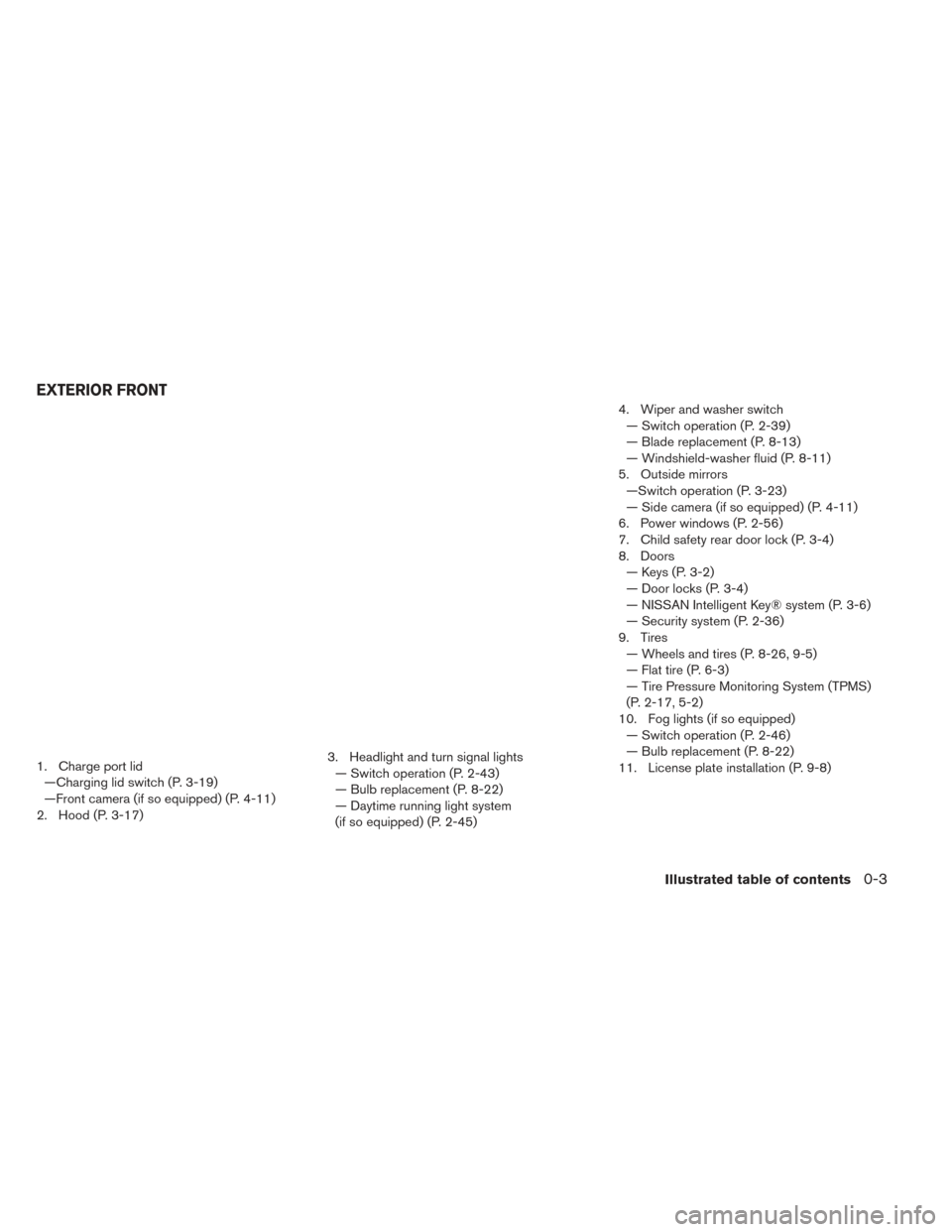
1. Charge port lid—Charging lid switch (P. 3-19)
—Front camera (if so equipped) (P. 4-11)
2. Hood (P. 3-17) 3. Headlight and turn signal lights
— Switch operation (P. 2-43)
— Bulb replacement (P. 8-22)
— Daytime running light system
(if so equipped) (P. 2-45) 4. Wiper and washer switch
— Switch operation (P. 2-39)
— Blade replacement (P. 8-13)
— Windshield-washer fluid (P. 8-11)
5. Outside mirrors —Switch operation (P. 3-23)
— Side camera (if so equipped) (P. 4-11)
6. Power windows (P. 2-56)
7. Child safety rear door lock (P. 3-4)
8. Doors — Keys (P. 3-2)
— Door locks (P. 3-4)
— NISSAN Intelligent Key® system (P. 3-6)
— Security system (P. 2-36)
9. Tires — Wheels and tires (P. 8-26, 9-5)
— Flat tire (P. 6-3)
— Tire Pressure Monitoring System (TPMS)
(P. 2-17, 5-2)
10. Fog lights (if so equipped) — Switch operation (P. 2-46)
— Bulb replacement (P. 8-22)
11. License plate installation (P. 9-8)
EXTERIOR FRONT
Illustrated table of contents0-3
Page 85 of 424
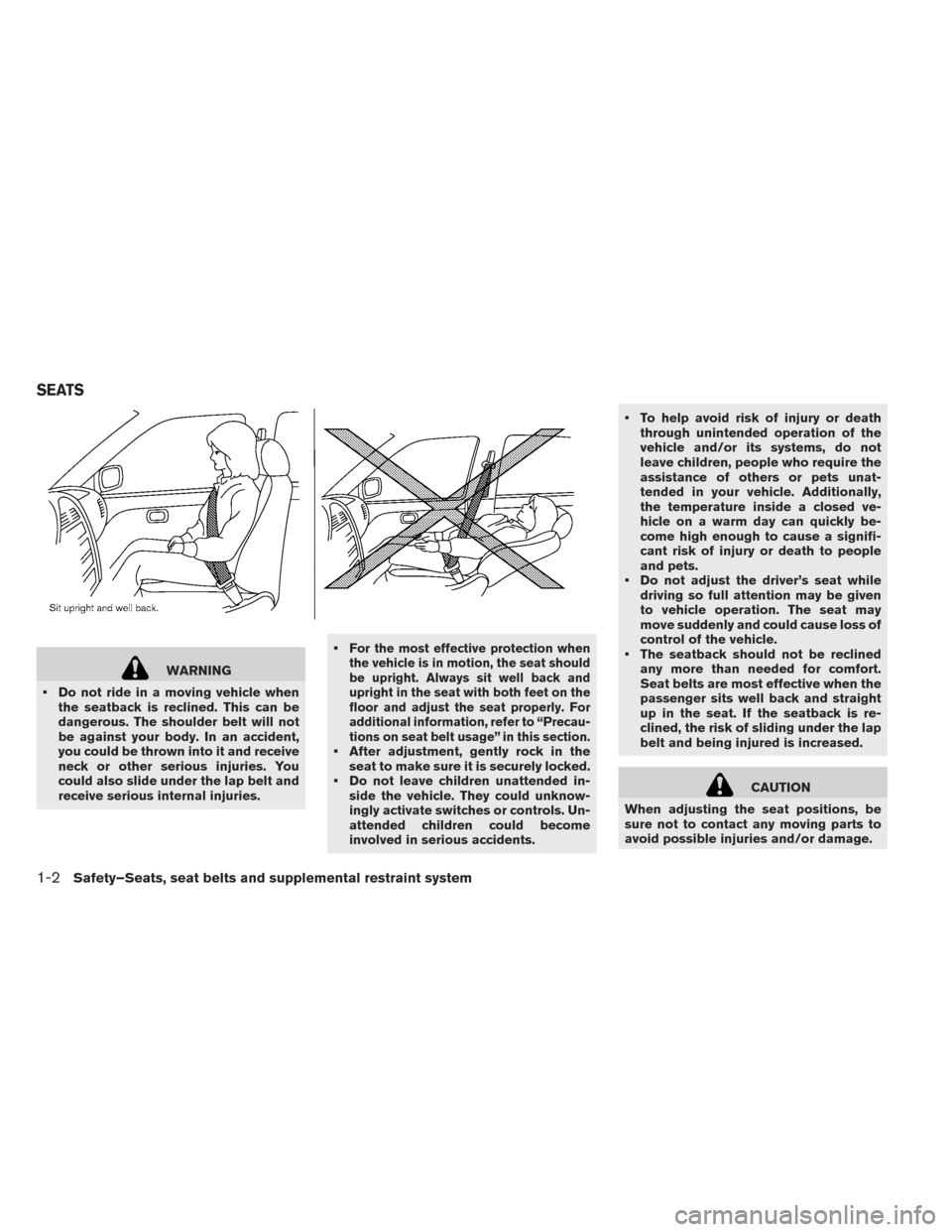
WARNING
• Do not ride in a moving vehicle when the seatback is reclined. This can be
dangerous. The shoulder belt will not
be against your body. In an accident,
you could be thrown into it and receive
neck or other serious injuries. You
could also slide under the lap belt and
receive serious internal injuries. •
For the most effective protection when
the vehicle is in motion, the seat should
be upright. Always sit well back and
upright in the seat with both feet on the
floor and adjust the seat properly. For
additional information, refer to “Precau-
tions on seat belt usage” in this section.
• After adjustment, gently rock in the
seat to make sure it is securely locked.
• Do not leave children unattended in- side the vehicle. They could unknow-
ingly activate switches or controls. Un-
attended children could become
involved in serious accidents. • To help avoid risk of injury or death
through unintended operation of the
vehicle and/or its systems, do not
leave children, people who require the
assistance of others or pets unat-
tended in your vehicle. Additionally,
the temperature inside a closed ve-
hicle on a warm day can quickly be-
come high enough to cause a signifi-
cant risk of injury or death to people
and pets.
• Do not adjust the driver’s seat while driving so full attention may be given
to vehicle operation. The seat may
move suddenly and could cause loss of
control of the vehicle.
• The seatback should not be reclined any more than needed for comfort.
Seat belts are most effective when the
passenger sits well back and straight
up in the seat. If the seatback is re-
clined, the risk of sliding under the lap
belt and being injured is increased.
CAUTION
When adjusting the seat positions, be
sure not to contact any moving parts to
avoid possible injuries and/or damage.
SEATS
1-2Safety–Seats, seat belts and supplemental restraint system
Page 94 of 424
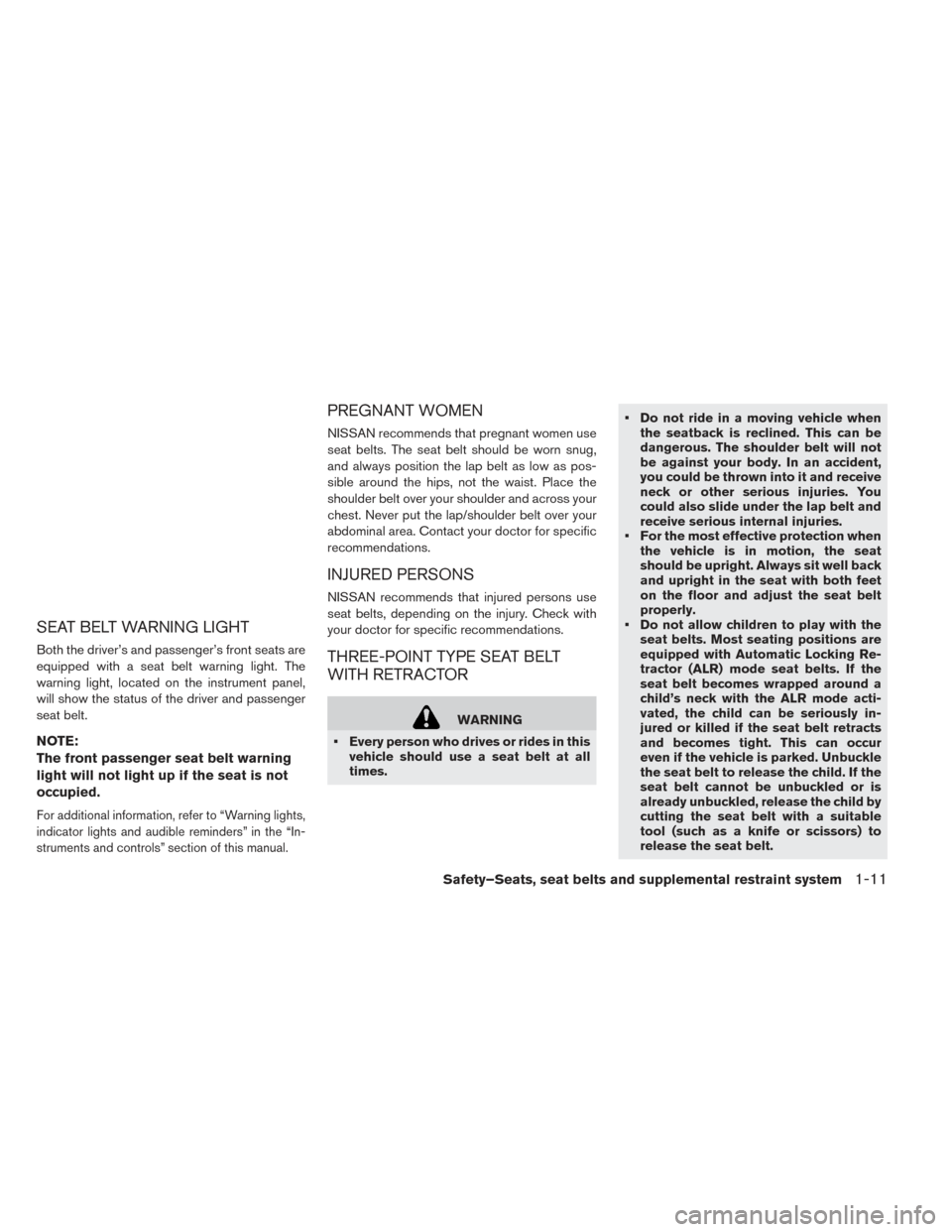
SEAT BELT WARNING LIGHT
Both the driver’s and passenger’s front seats are
equipped with a seat belt warning light. The
warning light, located on the instrument panel,
will show the status of the driver and passenger
seat belt.
NOTE:
The front passenger seat belt warning
light will not light up if the seat is not
occupied.
For additional information, refer to “Warning lights,
indicator lights and audible reminders” in the “In-
struments and controls” section of this manual.
PREGNANT WOMEN
NISSAN recommends that pregnant women use
seat belts. The seat belt should be worn snug,
and always position the lap belt as low as pos-
sible around the hips, not the waist. Place the
shoulder belt over your shoulder and across your
chest. Never put the lap/shoulder belt over your
abdominal area. Contact your doctor for specific
recommendations.
INJURED PERSONS
NISSAN recommends that injured persons use
seat belts, depending on the injury. Check with
your doctor for specific recommendations.
THREE-POINT TYPE SEAT BELT
WITH RETRACTOR
WARNING
• Every person who drives or rides in this vehicle should use a seat belt at all
times. • Do not ride in a moving vehicle when
the seatback is reclined. This can be
dangerous. The shoulder belt will not
be against your body. In an accident,
you could be thrown into it and receive
neck or other serious injuries. You
could also slide under the lap belt and
receive serious internal injuries.
• For the most effective protection when the vehicle is in motion, the seat
should be upright. Always sit well back
and upright in the seat with both feet
on the floor and adjust the seat belt
properly.
• Do not allow children to play with the seat belts. Most seating positions are
equipped with Automatic Locking Re-
tractor (ALR) mode seat belts. If the
seat belt becomes wrapped around a
child’s neck with the ALR mode acti-
vated, the child can be seriously in-
jured or killed if the seat belt retracts
and becomes tight. This can occur
even if the vehicle is parked. Unbuckle
the seat belt to release the child. If the
seat belt cannot be unbuckled or is
already unbuckled, release the child by
cutting the seat belt with a suitable
tool (such as a knife or scissors) to
release the seat belt.
Safety–Seats, seat belts and supplemental restraint system1-11
Page 95 of 424
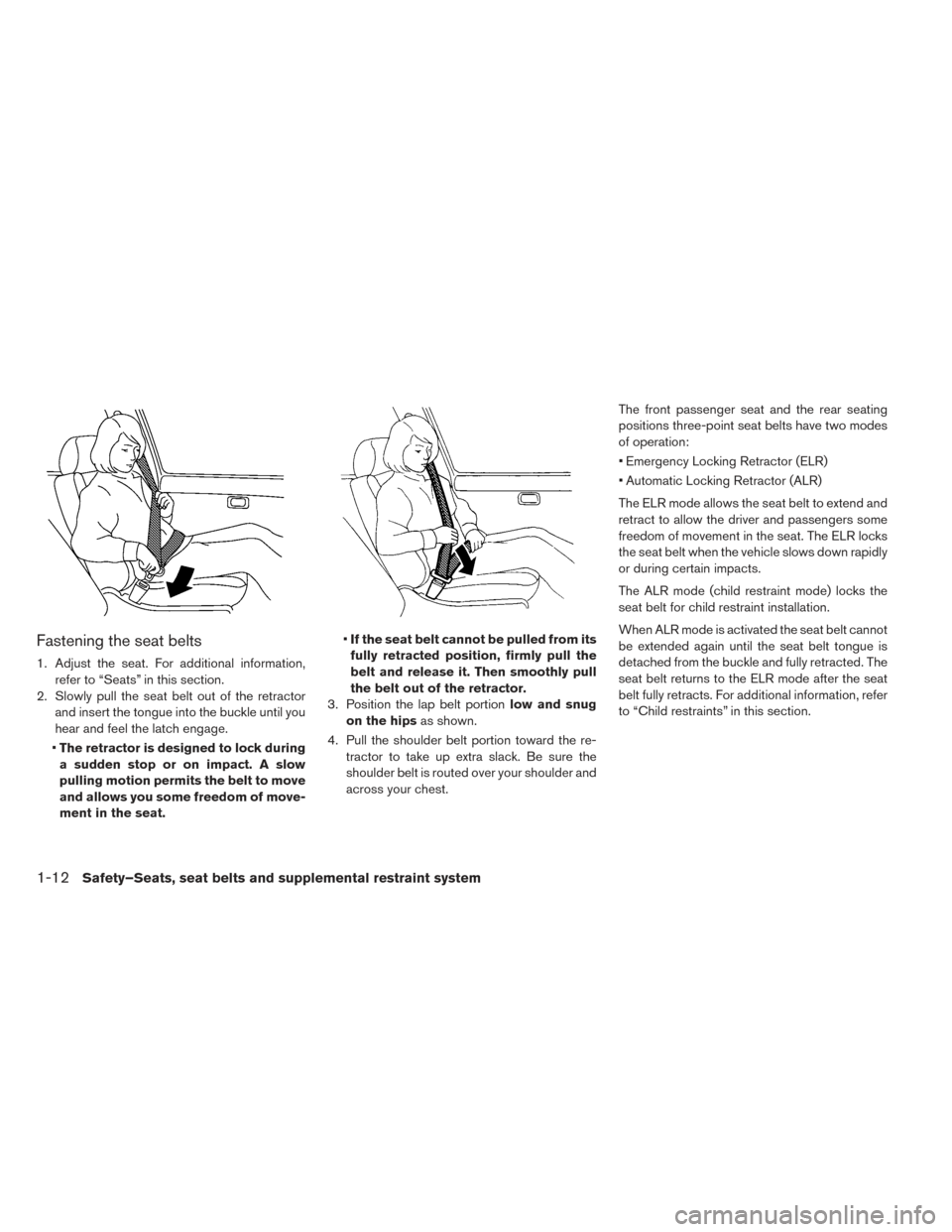
Fastening the seat belts
1. Adjust the seat. For additional information,refer to “Seats” in this section.
2. Slowly pull the seat belt out of the retractor and insert the tongue into the buckle until you
hear and feel the latch engage.
• The retractor is designed to lock during
a sudden stop or on impact. A slow
pulling motion permits the belt to move
and allows you some freedom of move-
ment in the seat. •
If the seat belt cannot be pulled from its
fully retracted position, firmly pull the
belt and release it. Then smoothly pull
the belt out of the retractor.
3. Position the lap belt portion low and snug
on the hips as shown.
4. Pull the shoulder belt portion toward the re- tractor to take up extra slack. Be sure the
shoulder belt is routed over your shoulder and
across your chest. The front passenger seat and the rear seating
positions three-point seat belts have two modes
of operation:
• Emergency Locking Retractor (ELR)
• Automatic Locking Retractor (ALR)
The ELR mode allows the seat belt to extend and
retract to allow the driver and passengers some
freedom of movement in the seat. The ELR locks
the seat belt when the vehicle slows down rapidly
or during certain impacts.
The ALR mode (child restraint mode) locks the
seat belt for child restraint installation.
When ALR mode is activated the seat belt cannot
be extended again until the seat belt tongue is
detached from the buckle and fully retracted. The
seat belt returns to the ELR mode after the seat
belt fully retracts. For additional information, refer
to “Child restraints” in this section.
1-12Safety–Seats, seat belts and supplemental restraint system
Page 96 of 424
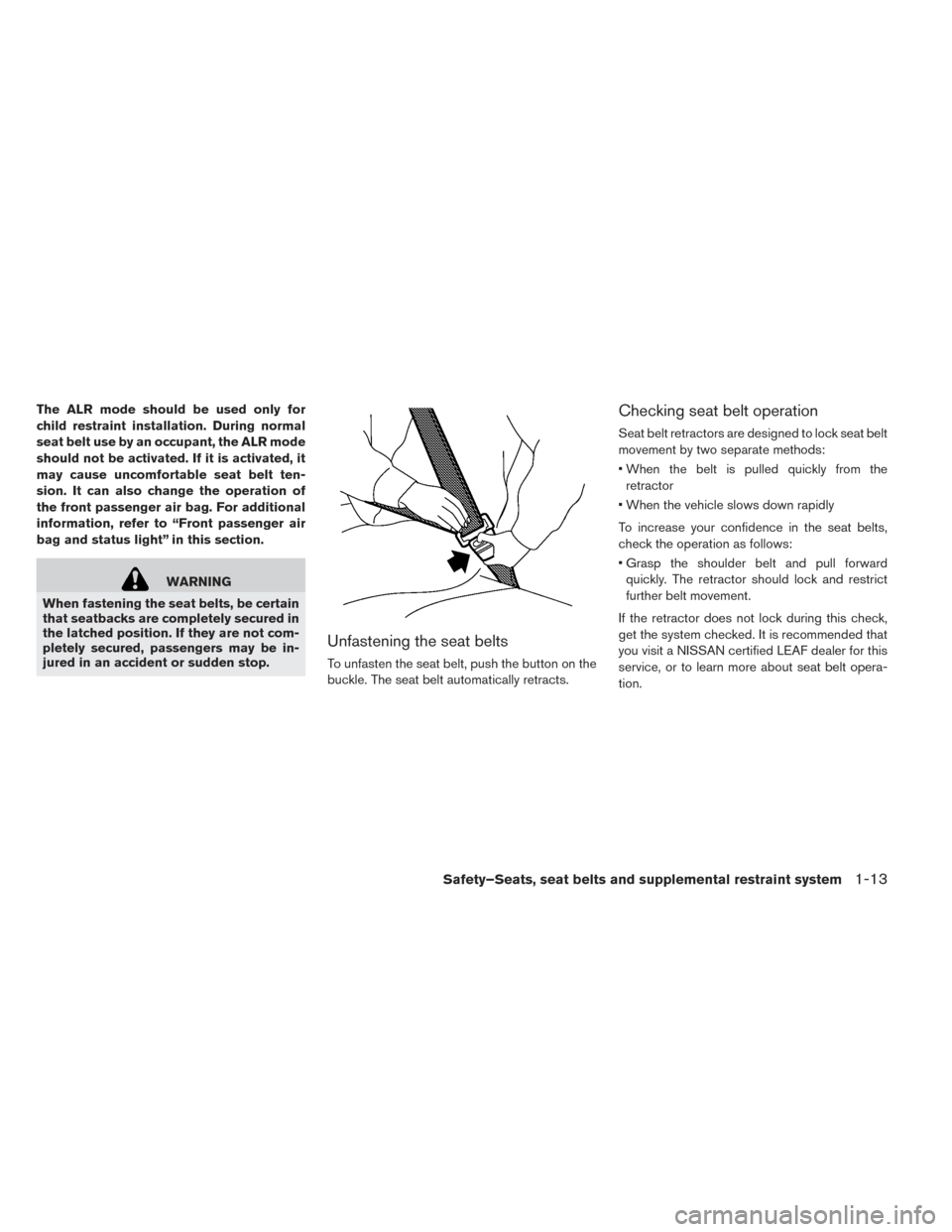
The ALR mode should be used only for
child restraint installation. During normal
seat belt use by an occupant, the ALR mode
should not be activated. If it is activated, it
may cause uncomfortable seat belt ten-
sion. It can also change the operation of
the front passenger air bag. For additional
information, refer to “Front passenger air
bag and status light” in this section.
WARNING
When fastening the seat belts, be certain
that seatbacks are completely secured in
the latched position. If they are not com-
pletely secured, passengers may be in-
jured in an accident or sudden stop.
Unfastening the seat belts
To unfasten the seat belt, push the button on the
buckle. The seat belt automatically retracts.
Checking seat belt operation
Seat belt retractors are designed to lock seat belt
movement by two separate methods:
• When the belt is pulled quickly from the retractor
• When the vehicle slows down rapidly
To increase your confidence in the seat belts,
check the operation as follows:
• Grasp the shoulder belt and pull forward quickly. The retractor should lock and restrict
further belt movement.
If the retractor does not lock during this check,
get the system checked. It is recommended that
you visit a NISSAN certified LEAF dealer for this
service, or to learn more about seat belt opera-
tion.
Safety–Seats, seat belts and supplemental restraint system1-13
Page 99 of 424
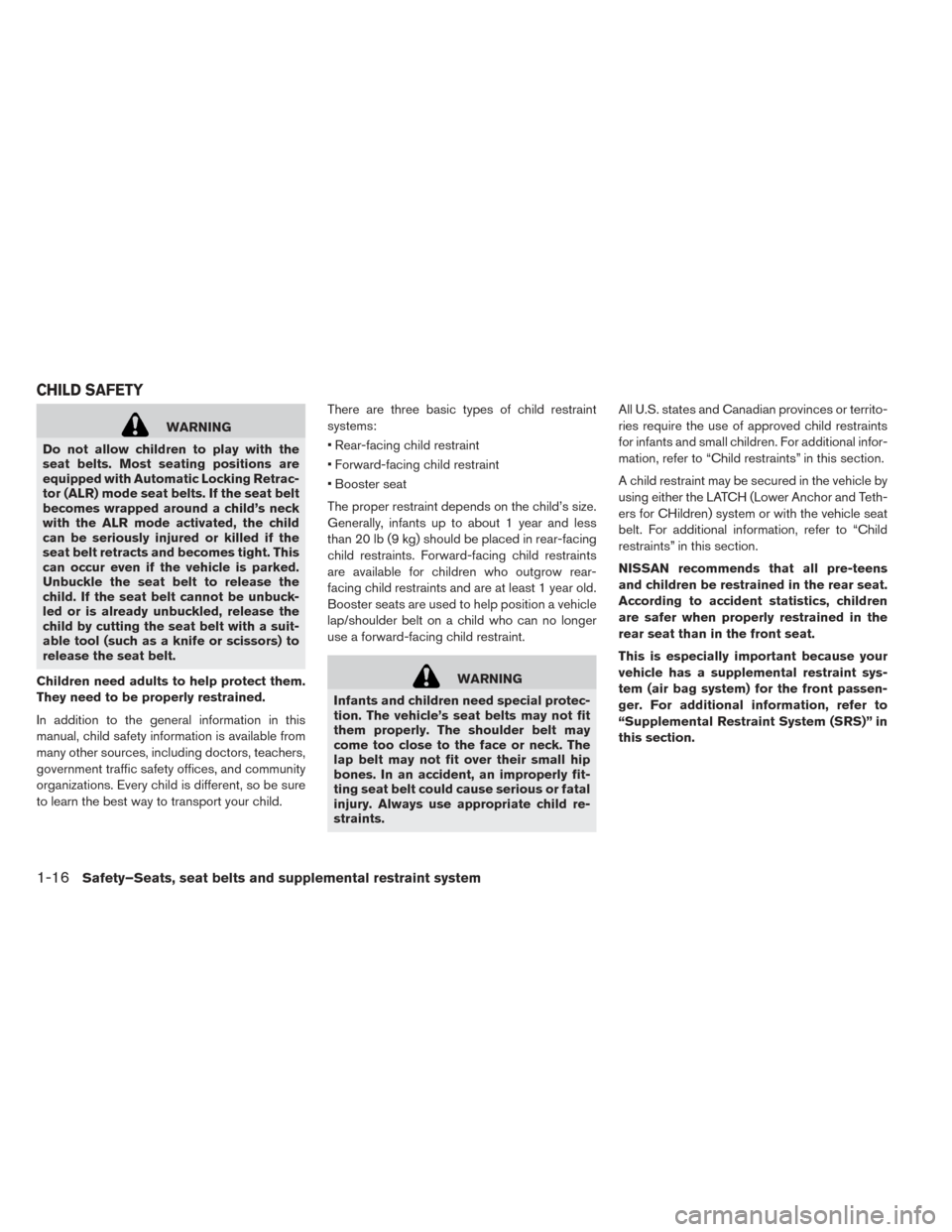
WARNING
Do not allow children to play with the
seat belts. Most seating positions are
equipped with Automatic Locking Retrac-
tor (ALR) mode seat belts. If the seat belt
becomes wrapped around a child’s neck
with the ALR mode activated, the child
can be seriously injured or killed if the
seat belt retracts and becomes tight. This
can occur even if the vehicle is parked.
Unbuckle the seat belt to release the
child. If the seat belt cannot be unbuck-
led or is already unbuckled, release the
child by cutting the seat belt with a suit-
able tool (such as a knife or scissors) to
release the seat belt.
Children need adults to help protect them.
They need to be properly restrained.
In addition to the general information in this
manual, child safety information is available from
many other sources, including doctors, teachers,
government traffic safety offices, and community
organizations. Every child is different, so be sure
to learn the best way to transport your child. There are three basic types of child restraint
systems:
• Rear-facing child restraint
• Forward-facing child restraint
• Booster seat
The proper restraint depends on the child’s size.
Generally, infants up to about 1 year and less
than 20 lb (9 kg) should be placed in rear-facing
child restraints. Forward-facing child restraints
are available for children who outgrow rear-
facing child restraints and are at least 1 year old.
Booster seats are used to help position a vehicle
lap/shoulder belt on a child who can no longer
use a forward-facing child restraint.
WARNING
Infants and children need special protec-
tion. The vehicle’s seat belts may not fit
them properly. The shoulder belt may
come too close to the face or neck. The
lap belt may not fit over their small hip
bones. In an accident, an improperly fit-
ting seat belt could cause serious or fatal
injury. Always use appropriate child re-
straints. All U.S. states and Canadian provinces or territo-
ries require the use of approved child restraints
for infants and small children. For additional infor-
mation, refer to “Child restraints” in this section.
A child restraint may be secured in the vehicle by
using either the LATCH (Lower Anchor and Teth-
ers for CHildren) system or with the vehicle seat
belt. For additional information, refer to “Child
restraints” in this section.
NISSAN recommends that all pre-teens
and children be restrained in the rear seat.
According to accident statistics, children
are safer when properly restrained in the
rear seat than in the front seat.
This is especially important because your
vehicle has a supplemental restraint sys-
tem (air bag system) for the front passen-
ger. For additional information, refer to
“Supplemental Restraint System (SRS)” in
this section.
CHILD SAFETY
1-16Safety–Seats, seat belts and supplemental restraint system
Page 108 of 424
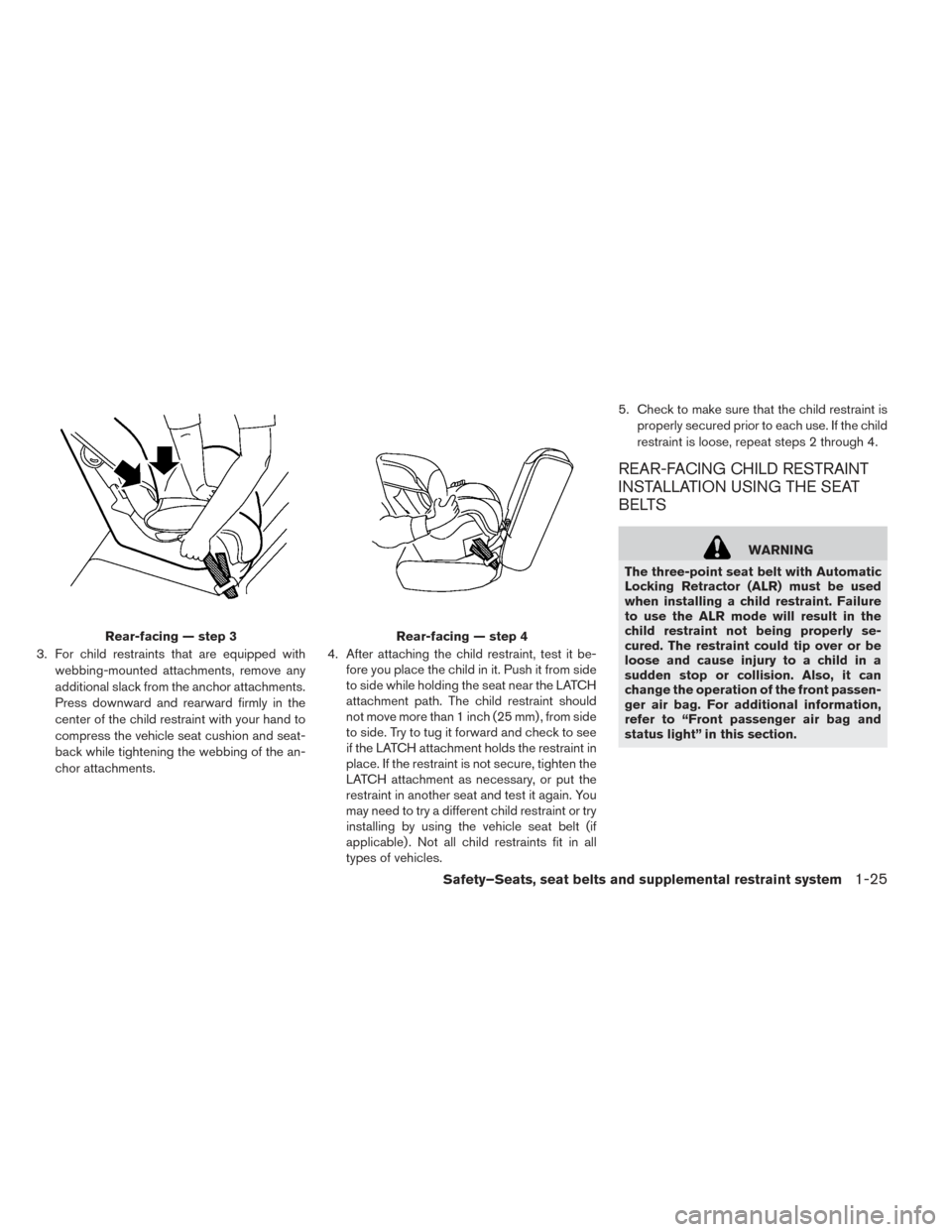
3. For child restraints that are equipped withwebbing-mounted attachments, remove any
additional slack from the anchor attachments.
Press downward and rearward firmly in the
center of the child restraint with your hand to
compress the vehicle seat cushion and seat-
back while tightening the webbing of the an-
chor attachments. 4. After attaching the child restraint, test it be-
fore you place the child in it. Push it from side
to side while holding the seat near the LATCH
attachment path. The child restraint should
not move more than 1 inch (25 mm) , from side
to side. Try to tug it forward and check to see
if the LATCH attachment holds the restraint in
place. If the restraint is not secure, tighten the
LATCH attachment as necessary, or put the
restraint in another seat and test it again. You
may need to try a different child restraint or try
installing by using the vehicle seat belt (if
applicable) . Not all child restraints fit in all
types of vehicles. 5. Check to make sure that the child restraint is
properly secured prior to each use. If the child
restraint is loose, repeat steps 2 through 4.
REAR-FACING CHILD RESTRAINT
INSTALLATION USING THE SEAT
BELTS
WARNING
The three-point seat belt with Automatic
Locking Retractor (ALR) must be used
when installing a child restraint. Failure
to use the ALR mode will result in the
child restraint not being properly se-
cured. The restraint could tip over or be
loose and cause injury to a child in a
sudden stop or collision. Also, it can
change the operation of the front passen-
ger air bag. For additional information,
refer to “Front passenger air bag and
status light” in this section.
Rear-facing — step 3Rear-facing — step 4
Safety–Seats, seat belts and supplemental restraint system1-25
Page 111 of 424
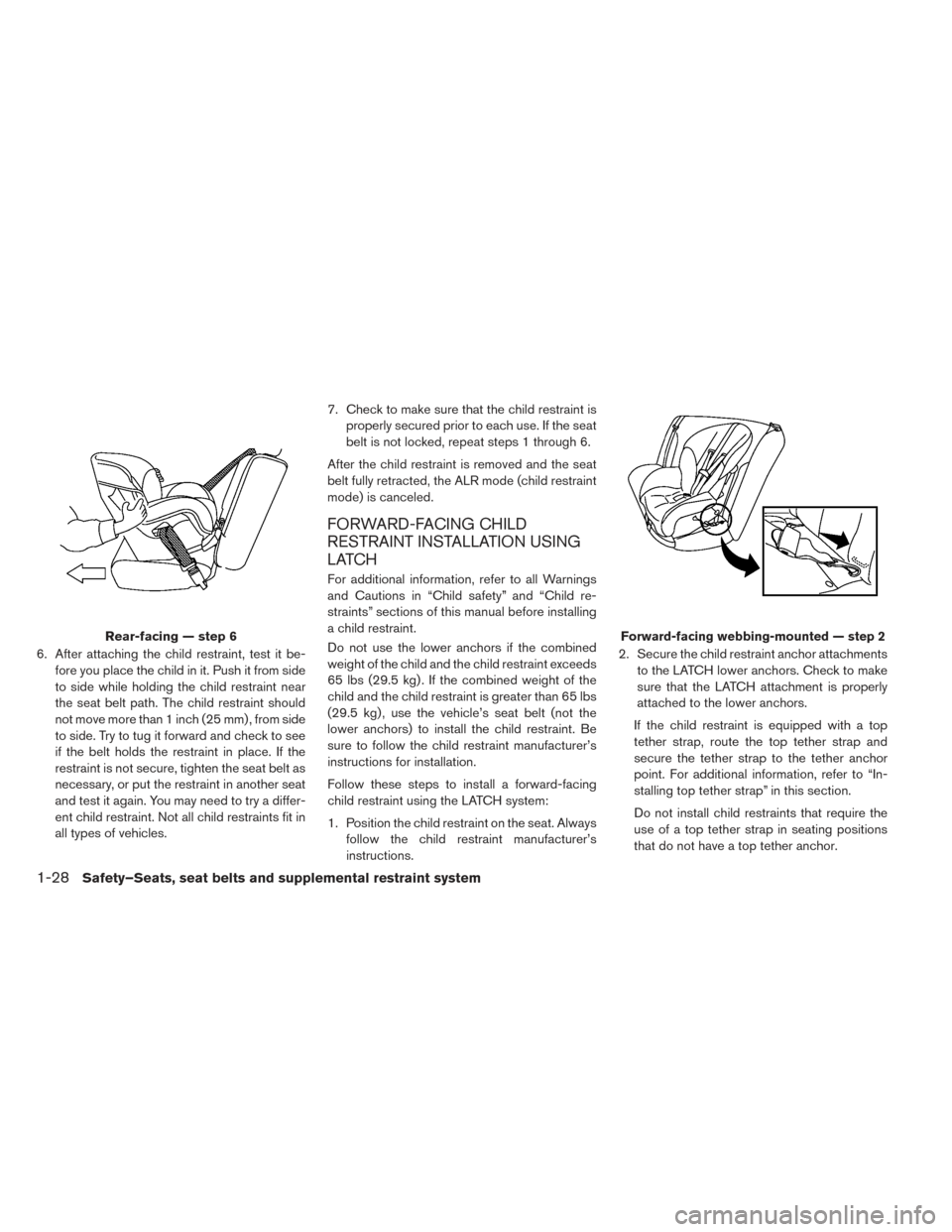
6. After attaching the child restraint, test it be-fore you place the child in it. Push it from side
to side while holding the child restraint near
the seat belt path. The child restraint should
not move more than 1 inch (25 mm) , from side
to side. Try to tug it forward and check to see
if the belt holds the restraint in place. If the
restraint is not secure, tighten the seat belt as
necessary, or put the restraint in another seat
and test it again. You may need to try a differ-
ent child restraint. Not all child restraints fit in
all types of vehicles. 7. Check to make sure that the child restraint is
properly secured prior to each use. If the seat
belt is not locked, repeat steps 1 through 6.
After the child restraint is removed and the seat
belt fully retracted, the ALR mode (child restraint
mode) is canceled.
FORWARD-FACING CHILD
RESTRAINT INSTALLATION USING
LATCH
For additional information, refer to all Warnings
and Cautions in “Child safety” and “Child re-
straints” sections of this manual before installing
a child restraint.
Do not use the lower anchors if the combined
weight of the child and the child restraint exceeds
65 lbs (29.5 kg) . If the combined weight of the
child and the child restraint is greater than 65 lbs
(29.5 kg) , use the vehicle’s seat belt (not the
lower anchors) to install the child restraint. Be
sure to follow the child restraint manufacturer’s
instructions for installation.
Follow these steps to install a forward-facing
child restraint using the LATCH system:
1. Position the child restraint on the seat. Always follow the child restraint manufacturer’s
instructions. 2. Secure the child restraint anchor attachments
to the LATCH lower anchors. Check to make
sure that the LATCH attachment is properly
attached to the lower anchors.
If the child restraint is equipped with a top
tether strap, route the top tether strap and
secure the tether strap to the tether anchor
point. For additional information, refer to “In-
stalling top tether strap” in this section.
Do not install child restraints that require the
use of a top tether strap in seating positions
that do not have a top tether anchor.
Rear-facing — step 6Forward-facing webbing-mounted — step 2
1-28Safety–Seats, seat belts and supplemental restraint system